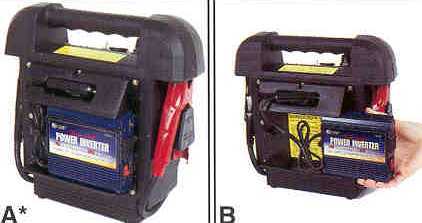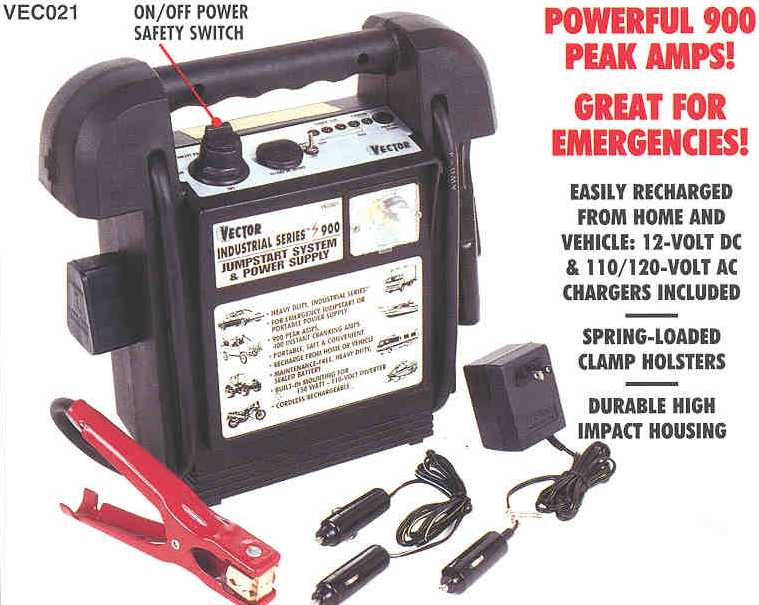17 Amp-Hr 12 Volt DC & 120 Volt AC Power Supply



The MEGA STATION AC (Mg Stn AC) is a 17 Amp-Hr gel cell
reduced lead-acid battery that provides 12 Volts DC & 120 Volts AC. The Mg Stn AC has built
in jumper cables protected by a keyless ON/OFF safety switch and a cigarette lighter output
with automatic short-circuit protection. Both, the jumper cables and cigarette lighter
output, supply 12 Volts DC. In addition, a detachable 150 watt continuous 300 watt peak
(DC to AC) inverter provides 120 Volts AC. The Mg Stn AC will power most anything from-
cell phones, laptops, printers, CD players, HTs, battery chargers, etc.
Unlike a ni-cad battery, that has memory, you don't need to completely discharge the
Mg Stn AC before recharging it. It can be recharged when it is partially or completely
discharged. This allows you the freedom to be able to recharge the Mg Stn AC any time you
wish. Therefore, the unit can always be "topped off" and ready for action or emergencies.
The status lights on the Mg Stn AC indicate when the unit is becoming low on charge and
should be recharged and when the unit is fully recharged. Since a gel cell battery only loses
approximately 6-8% of it's charge per month a fully charged Mg Stn AC only needs to be
recharged every 6-8 months when it sits. Never leave the unit in a completely discharged
state. Instead, simply recharge the unit overnight and it will be ready to go in the
morning.
In addition to the supplied wall charger, the Mg Stn AC also comes complete with a
cigarette lighter adapter for charging via the automobile. In this procedure the car's
regulator determines when the battery is at the proper voltage and ceases the charging cycle.
Weight: 17 lbs (w/o inverter) 19.5 lbs (w/ inverter)
Dimensions: 6.5 x 12 x 12"
Price: $99.95 + $16.50 s&h
HOW MUCH LIFE CAN BE EXPECTED FROM A BATTERY?
If life was ideal, a 20 Amp-Hr battery would put out 20 Amps for 1 Hour, or 1 Amp for 20 hours before it was exhausted.
Rule #1 Life is not ideal.
Rule #2 All batteries, are measured over a 20 hour period (therefore, 1 Amp for 20 hours is correct). This is called the C20 rate, and the reason that you get a full 1 Amp x 20 hours for a 20 Amp-Hr battery
Rule #3 If a battery is discharged faster than the C20 rate, the capacity of the battery will be diminished. If you draw as many Amps as it's Amp-Hr rating (i.e. 20 Amps), it will last about 60% of an hour or 36 minutes at which point the battery will appear to be discharged. (Ignore the rest of this rule unless you're a technoid). The interface at the Acid/Plates has been exhausted of the electrons faster than they could be replenished with those located within the plate. You'll then walk away from the battery thinking it's dead, and return sometime later only to find out that some useful charge has "returned" to the battery. The reason is that those unused electrons have had time to migrate to where the interface occurs, so the battery has "come back to life"., but 20 Amps for only 36 minutes.
Rule #4 DON'T LEAVE A BATTERY COMPLETELY DISCHARGED FOR ANY LENGTH OF TIME OR IT WILL BE DAMAGED. When in doubt, top it off!
Rule #5 Don't overcharge a battery such as a POCKET STATION or POCKET GENERATOR by leaving it hooked up to a wall charger for months at a time unless it has a regulator. Our POWER STATION has such a regulator, but to save weight and size, the POCKET STATIONS and POCKET GENERATOR do not have an internal regulator for the wall charger
Rule #6 THEY CAN BE LEFT PLUGGED INDEFINITELY INTO THE CAR FOR CHARGING! Due to the fact that they are in parallel with the car battery and the cars has a battery regulator, a battery would not experience overcharging. HOW MUCH LIFE CAN BE EXPECTED FROM A BATTERY for an HF RIG?
Rule #7 Even though your HF rig states 20 Amps during transmit this occurs only during voice peaks on SSB, it averages only about 6 amps for transmit when you look at the area under the current vs. time curve. Define the current during TX as 6 Amps, and during RX as 1.5 Amps or 3/2 Amp.
Example: During an hour you talk for 20 minutes (i.e. 1/3 of the time or 1/3 Hr.) and listen for 40 minutes (2/3 Hr). Amp-Hrs for TX + Amp-Hrs for RX = Total Amp-Hrs used for 1 Hr of operation Current AVG Tx x Time + Current AVG R x Time = Amp-Hr Required 6 Amps (Avg) x 1/3 Hr + 3/2 Amps (AVG) x 2/3 Hr = ?Amp-Hr 2 Amp-Hr + 1 Amp-Hr = 3 Amp-Hr So you can easily run an HF rig for a few hours with a POWER STATION or POCKET STATION 7.